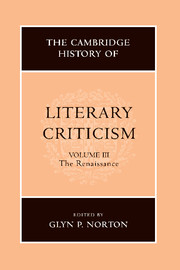Book contents
- Frontmatter
- Introduction
- READING AND INTERPRETATION: AN EMERGING DISCOURSE OF POETICS
- POETICS
- I Humanist classifications
- II The rediscovery and transmission of materials
- III Rhetorical poetics
- IV Literary forms
- 20 Italian epic theory
- 21 The lyric
- 22 Renaissance theatre and the theory of tragedy
- 23 Elizabethan theatrical genres and literary theory
- 24 Defining comedy in the seventeenth century: moral sense and theatrical sensibility
- 25 Dialogue and discussion in the Renaissance
- 26 The essay as criticism
- 27 The genres of epigram and emblem
- 28 Humour and satire in the Renaissance
- THEORIES OF PROSE FICTION
- CONTEXTS OF CRITICISM: METROPOLITAN CULTURE AND SOCIO-LITERARY ENVIRONMENTS
- VOICES OF DISSENT
- STRUCTURES OF THOUGHT
- NEOCLASSICAL ISSUES: BEAUTY, JUDGEMENT, PERSUASION, POLEMICS
- A SURVEY OF NATIONAL DEVELOPMENTS
- Bibliography
- Index
- References
26 - The essay as criticism
from IV - Literary forms
Published online by Cambridge University Press: 28 March 2008
- Frontmatter
- Introduction
- READING AND INTERPRETATION: AN EMERGING DISCOURSE OF POETICS
- POETICS
- I Humanist classifications
- II The rediscovery and transmission of materials
- III Rhetorical poetics
- IV Literary forms
- 20 Italian epic theory
- 21 The lyric
- 22 Renaissance theatre and the theory of tragedy
- 23 Elizabethan theatrical genres and literary theory
- 24 Defining comedy in the seventeenth century: moral sense and theatrical sensibility
- 25 Dialogue and discussion in the Renaissance
- 26 The essay as criticism
- 27 The genres of epigram and emblem
- 28 Humour and satire in the Renaissance
- THEORIES OF PROSE FICTION
- CONTEXTS OF CRITICISM: METROPOLITAN CULTURE AND SOCIO-LITERARY ENVIRONMENTS
- VOICES OF DISSENT
- STRUCTURES OF THOUGHT
- NEOCLASSICAL ISSUES: BEAUTY, JUDGEMENT, PERSUASION, POLEMICS
- A SURVEY OF NATIONAL DEVELOPMENTS
- Bibliography
- Index
- References
Summary
Before Michel de Montaigne and Francis Bacon used the word to designate their respective works (unlike in all but a few details), the essay began to take form in the epistolary writings of Cicero and Seneca, Plutarch's Moralia, the compilations of sententiae, exempla, and lectiones of late antiquity and their humanist counterparts. Montaigne gave the title Essais to his 1580 volume as an appropriate designation for a work in which a variety of seemingly unrelated historical and moral examples culled from his readings are pondered and compared, apparently in desultory fashion, for their relative value, thereby conjugating etymologically the exagium of essay and the krinein of criticism. Similarly, the ‘fragments of my conceites’ that Bacon published in 1597 under the title Essays are a selection of adages and aphorisms from his many commonplace-books, carefully contrived to convey practical precepts in a methodical and convincing manner. In ‘Of studies’, he aptly summarizes his underlying strategy: ‘Read not to contradict and confute; nor to believe and take for granted; nor to find talk and discourse; but to weigh and consider’, recalling Montaigne's deliberative practice and anticipating Charles-Augustin Sainte-Beuve's definition of a critic as simply a person who knows how to read and who shows others how to read.
Born of otium, Montaigne's Essais represent originally his attempt to capture and tame the chimeras and fantastic monsters which idleness and leisure generated in his mind. Progressively, however, he perceives disorder as natural order, and discursive inconclusiveness as a prerequisite to the immediate reproduction of the reality of his thought and self. In opposition to those who sought definitions and conclusions, Montaigne was increasingly concerned with comparisons and differences, viewing the essay finally as a record of diverse occurrences, irresolute and contradictory ideas: ‘I am unable to stabilize my subject’, he writes, ‘it staggers confusedly along with a natural drunkenness’.
- Type
- Chapter
- Information
- The Cambridge History of Literary Criticism , pp. 271 - 277Publisher: Cambridge University PressPrint publication year: 1999
References
- 2
- Cited by



